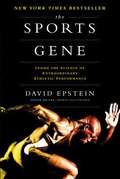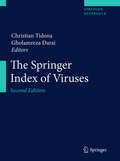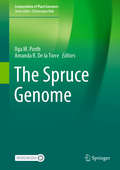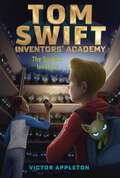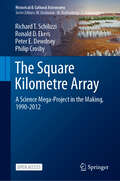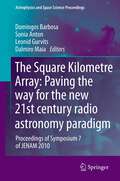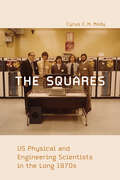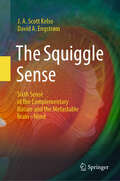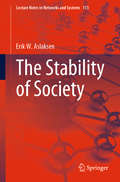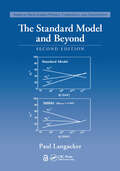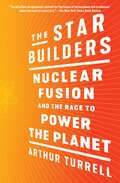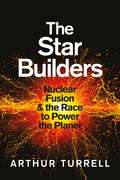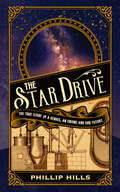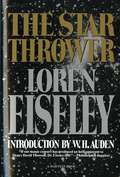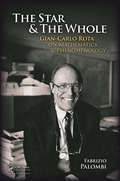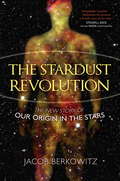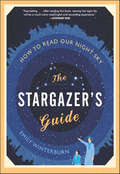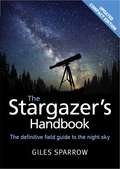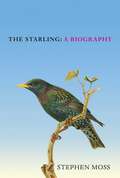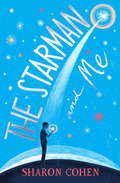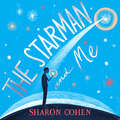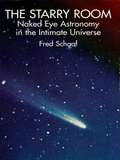- Table View
- List View
The Sports Gene: Inside the Science of Extraordinary Athletic Performance
by David EpsteinThe New York Times bestseller - with a new afterword about early specialization in youth sports.The debate is as old as physical competition. Are stars like Usain Bolt, Michael Phelps, and Serena Williams genetic freaks put on Earth to dominate their respective sports? Or are they simply normal people who overcame their biological limits through sheer force of will and obsessive training?In this controversial and engaging exploration of athletic success and the so-called 10,000-hour rule, David Epstein tackles the great nature vs. nurture debate and traces how far science has come in solving it. Through on-the-ground reporting from below the equator and above the Arctic Circle, revealing conversations with leading scientists and Olympic champions, and interviews with athletes who have rare genetic mutations or physical traits, Epstein forces us to rethink the very nature of athleticism.
The Springer Index of Viruses
by Christian Tidona Gholamreza DaraiThe continuous growth of knowledege makes it very difficult for scientists to retrieve comprehensive and accurate data on viruses. The desired information is often dispersed in a variety of books, journals and online resources. This encyclopedia presents the latest facts about all known virus in a standardized form created by hundreds of the world's leading virologists. Virus taxonomy represents the basic framework that allows an understanding of the complex evolutionary process that continuously takes place among viruses and their hosts. Each of the 300 taxonomically ordered chapters includes detailed information on individual genus members, historical events, the hosts they can affect (animal, man or plant), virion morphology, genome properties, replication strategy, properties of individual transcripts and proteins, sequence accession numbers, biological properties, diseases, recombinant vector constructs, vaccine strains, key references, as well as a high-resolution particle image and a drawing of the genome organization. Its high content of easily accessible detail information makes this Encyclopedia an indispensable tool for both researchers and lecturers. The new edition includes the recent discoveries made in this field as well as new viruses which have been discovered.
The Spruce Genome (Compendium of Plant Genomes)
by Ilga M. Porth Amanda R. De la TorreThis book offers comprehensive information on the genomics of spruces (Picea spp.), naturally abundant conifer tree species that are widely distributed in the Northern Hemisphere. Due to their tremendous ecological and economic importance, the management of forest genetic resources has chiefly focused on conservation and tree improvement. A draft genome sequence of the 20-gigabase Norway spruce genome was published in the journal Nature in 2013. Continuous efforts to improve the spruce genome assembly are underway, but are hindered by the inherent characteristics of conifer genomes: high amounts of repetitive sequences (introns and transposable elements) in the genome and large gene family expansions with regards to abiotic stress, secondary metabolism and spruces' defense responses to pathogens and herbivory. This book presents the latest information on the status of genome assemblies, provides detailed insights into transposable elements and methylation patterns, and highlights the extensive genomic resources available for inferring population genomics and climate adaptation, as well as emerging genomics tools for tree improvement programs. In addition, this volume features whole-genome comparisons among conifer species, and demonstrates how functional genomics can be used to improve gene function annotations. The book closes with an outlook on emerging fields of research in spruce genomics.
The Spybot Invasion (Tom Swift Inventors' Academy #5)
by Victor AppletonTom and his friends get to the bottom of a practical joke gone wrong in this fifth novel in Tom Swift Inventors&’ Academy—perfect for fans of The Hardy Boys or Alex Rider.It&’s another day at the Swift Academy when Tom starts finding little troll-like figures around campus. And he&’s not the only one. Much to the amusement and curiosity of students, these dolls are appearing all over the school. But even after they&’re collected by faculty, a second wave mysteriously appears—except these replacements record audio and play it back for surrounding listeners. Before everyone knows it, secrets and gossip are revealed across campus, and suddenly the figures aren&’t nearly as fun as they used to be. What seemed to start as a practical joke quickly turns into something more serious when yet another wave of more advanced robots infiltrates the school. And these record and project video footage. It seems that no one is safe from the spybots as the academy spirals into mayhem, and it&’s up to Tom and his friends to track down the culprit behind the invasion.
The Square Kilometre Array: A Science Mega-Project in the Making, 1990-2012 (Historical & Cultural Astronomy)
by Ronald D. Ekers Richard T. Schilizzi Peter E. Dewdney Philip CrosbyThe Square Kilometre Array (SKA) is a grand vision project to build the most sensitive radio telescope in the world. This open access book tells the story of its development – a story of transformational science, innovative engineering, and global collaboration. Its journey has been long and complex, reflecting the many issues faced in creating an affordable design, choosing a site, and developing a viable global organisation starting from a simple working group of far-sighted and persistent astronomers in 1993.The book begins with the emergence of the SKA concept and the first working group. It traces the development of global scientific and engineering collaborations and ever more comprehensive governance structures for the SKA, the involvement and roles of funding agencies and governments, and the long, political site selection process. This occurred alongside efforts to overcome technical barriers and the difficult process of selecting technology. It follows these themes up to the point in 2012 when the project had just transitioned from a collaboration to a legal entity and the dual site decision was made – a pivotal moment when it was clear the SKA arrays would be built. The book is based on the authors’ personal experience at the leading edge of the project over many years, as well as access to hitherto unpublished material from project archives, interviews, and presentations from many of the key players at a specially convened conference. It has a Foreword written by John Womersley, former Chair of the Agencies SKA Group and SKA Organisation Board. The book is intended for an audience ranging from funding agencies and governments involved in major research infrastructures, to historians of science and professional researchers studying mega-projects, to the astronomy and physics communities in general and interested lay readers.
The Square Kilometre Array: Paving the way for the new 21st century radio astronomy paradigm
by Sonia Anton Domingos Barbosa Dalmiro Maia Leonid Gurvits: The Square Kilometre Array (SKA) will provide more than one order of magnitude improvement in sensitivity compared with any existing radio telescope over a wavelength range of several hundred to one, from decametric to microwave wavelengths. It will revolutionize the study of the most abundant element in the Universe, hydrogen, from the epoch of reionisation to the present-day, probing the onset formation period of the very first stars, will closely scan proto-planets and, through the precision timing of pulsars, will detect the distortions of space-time due to gravitational radiation. The SKA is a sensing network spanning 3000 km from its centre and with a collecting area of more than 1 square kilometre, using technologies of the 21st century. The SKA will make the study of a wide range of phenomena initially studied at other wavelengths possible at radio wavelengths, as well as opening a new discovery window on new phenomena at radio wavelengths. Symposium 7 of the JENAM 2010 aimed at bringing these diverse opportunities to the attention of both theoretical and observational astronomers working at all wavelengths, including the potential for synergies with other facilities. The meeting highlighted the scientific potential of the SKA, discussed scientific priorities and their impact on the design of the SKA, explored the synergies between the SKA and other next-generation astronomical facilities in different wavelength domains such as the ALMA, ELTs, LSST, JWST, GRE, IXO, Gaia and Euclid, and high-energy facilities (Auger), explored the "cyber-infrastructure" that may become available for the distribution and distributed analysis of SKA data.
The Squares: US Physical and Engineering Scientists in the Long 1970s (Inside Technology)
by Cyrus C. ModyWhen ungroovy scientists did groovy science: how non-activist scientists and engineers adapted their work to a rapidly changing social and political landscape.In The Squares, Cyrus Mody shows how, between the late 1960s and the early 1980s, some scientists and engineers who did not consider themselves activists, New Leftists, or members of the counterculture accommodated their work to the rapidly changing social and political landscape of the time. These &“square scientists,&” Mody shows, began to do many of the things that the counterculture urged: turn away from military-industrial funding, become more interdisciplinary, and focus their research on solving problems of civil society. During the period Mody calls &“the long 1970s,&” ungroovy scientists were doing groovy science. Mody offers a series of case studies of some of these collective efforts by non-activist scientists to use their technical knowledge for the good of society. He considers the region around Santa Barbara and the interplay of public universities, think tanks, established firms, new companies, philanthropies, and social movement organizations. He looks at Stanford University&’s transition from Cold War science to commercialized technoscience; NASA&’s search for a post-Apollo mission; the unsuccessful foray into solar energy by Nobel laureate Jack Kilby; the &“civilianization&” of the US semiconductor industry; and systems engineer Arthur D. Hall&’s ill-fated promotion of automated agriculture.
The Squiggle Sense: Sixth Sense of the Complementary Nature and the Metastable Brain~Mind
by David A. Engstrøm J. A. KelsoEither/or thinking is a major stumbling block to human development and understanding. In this book Kelso & Engstrøm offer a whole new way of looking at the world, awakening a “sixth sense” that people didn’t realize they had. It draws on the profound relationship between nature’s many complementary contraries and the paradigm shifting science of coordination called Coordination Dynamics. The human brain~mind, through the multi- and metastable modes of its coordination dynamics, gives rise to a sentient faculty called the squiggle sense. Nature's contraries are perceived not only as opposing polar states, but as coexisting complementary tendencies, symbolized by the squiggle (~). Use this book to nudge your brain~mind into its metastable mode again and again, to better perceive the complementary dances of contraries, and to transcend the detrimental narrow-mindedness of polarized, either/or thinking. As a "Metastabilian" you can wield your squiggle sense to enhance and advance your life!
The Stability of Society (Lecture Notes in Networks and Systems #113)
by Erik W. AslaksenIn this book, Erik W. Aslaksen builds on the view and model of society introduced in The Social Bond (Springer 2018), which portrays society as an information-processing system, and as both the result of the information and of the environment in which the information processing takes place. The processing power is provided by the individual, but is also greatly enhanced by the interaction between individuals, forming the collective intelligence that drives the evolution of society. In particular, this book focuses on the stability of that evolution, an issue that is of increasing concern given the current polarisation of the world society, both politically and economically, and the resultant interference in the operation of the collective intelligence. When we approach society as a genus and its evolution as a sequence of species, such as the family, clan, fiefdom, kingdom, and nation-state, the development of the next species – the world society – is now being thwarted by the desire of a minority to maintain a hegemonial position that resulted from a singularity in the process.
The Standard Model and Beyond (Series in Particle Physics, Cosmology and Gravitation)
by Paul LangackerThis new edition of The Standard Model and Beyond presents an advanced introduction to the physics and formalism of the standard model and other non-abelian gauge theories. It provides a solid background for understanding supersymmetry, string theory, extra dimensions, dynamical symmetry breaking, and cosmology. In addition to updating all of the experimental and phenomenological results from the first edition, it contains a new chapter on collider physics; expanded discussions of Higgs, neutrino, and dark matter physics; and many new problems. The book first reviews calculational techniques in field theory and the status of quantum electrodynamics. It then focuses on global and local symmetries and the construction of non-abelian gauge theories. The structure and tests of quantum chromodynamics, collider physics, the electroweak interactions and theory, and the physics of neutrino mass and mixing are thoroughly explored. The final chapter discusses the motivations for extending the standard model and examines supersymmetry, extended gauge groups, and grand unification. Thoroughly covering gauge field theories, symmetries, and topics beyond the standard model, this text equips readers with the tools to understand the structure and phenomenological consequences of the standard model, to construct extensions, and to perform calculations at tree level. It establishes the necessary background for readers to carry out more advanced research in particle physics. Supplementary materials are provided on the author’s website and a solutions manual is available for qualifying instructors.
The Star Book: An Introduction to Stargazing and the Solar System
by Peter GregoSee the night sky like you have never seen it before with this all-encompassing guide to astronomy. Learn all there is to know about the layout of the skies, the positions of the main constellations and the names of the brightest stars, so you can become a backyard astronomer in no time at all. With easy-to-use star charts, photographs and observational drawings of objects visible from both hemispheres, The Star Book will take your understanding and enjoyment of stargazing to the next level. Whether you use binoculars or a telescope, or even if you have no optical aid at all, there are enough celestial sights to keep anyone enthralled for a lifetime. The Star Book provides a quick and simple reference to the major stars and constellations, with easy-to-use star charts, finder charts, high-quality images and observational drawings covering the key stars viewable from all over the world. Author Peter Grego, also includes a brief introduction to the history of astronomy, an easy-to-follow explanation of the life-cycle of stars, from ignition to collapse, and information about deep sky objects such as nebulae and globular clusters. This fascinating, attractive and accessible book will become a trusted resource to make sense of the night skies, and is a wonderful gift for anyone with even a passing interest in astronomy.
The Star Book: Stargazing Throughout the Seasons in the Northern Hemisphere
by Peter GregoStargazing Throughout the Seasons in the Northern Hemisphere is an excerpt from The Star Book that guides you through the night skies in the Northern Hemisphere, through wide-angle star charts. Looking at the main constellations, stars and celestial showpieces of the northern celestial sphere, beginning with constellations around the north pole and then taking a season by season view. Most northern constellations are as familiar to today's stargazers as they were to the ancient Greeks.Everyone is interested in the stars and on a clear night astonished by them. Stargazing Throughout the Seasons in the Northern Hemisphere will answer any questions you may have when you look up into the night sky.
The Star Book: Stargazing Throughout the Seasons in the Southern Hemisphere
by Peter GregoStargazing Throughout the Seasons in the Southern Hemisphere is an excerpt from The Star Book that guides you through the night skies in the Southern Hemisphere, through wide-angle star charts. Looking at the main constellations, stars and celestial showpieces of the southern celestial sphere, beginning with constellations around the south celestial pole and then taking a season by season view. Far southern stars had to wait until the early 17th century to be mapped by European explorers.Everyone is interested in the stars and on a clear night astonished by them. Stargazing Throughout the Seasons in the Southern Hemisphere will answer any questions you may have when you look up into the night sky.
The Star Builders: Nuclear Fusion and the Race to Power the Planet
by Arthur TurrellFrom a young, award-winning scientist, a look at one of the most compelling and historic turning points of our time—the race to harness the power of the stars and produce controlled fusion, creating a practically unlimited supply of clean energy.The most important energy-making process in the universe takes place inside stars. The ability to duplicate that process in a lab, once thought out of reach, may now be closer than we think. Today, all across the world teams of scientists are being assembled by the world&’s boldest entrepreneurs, big business, and governments to solve what is the most difficult technological challenge humanity has ever faced: building the equivalent of a star on earth. If their plans to capture star power are successful, they will unlock thousands, potentially millions, of years of clean, carbon-free energy. Not only would controlled nuclear fusion go a long way toward solving the climate crisis, it could help make other highly desired technological ambitions possible—like journeying to the stars. Given the rising alarm over deterioration of the environment, and the strides being made in laser and magnetic field technology, powerful momentum is gathering behind fusion and the possibilities it offers. Arthur Turrell is an award-winning young plasma physicist with a unique talent for making complex science accessible. In The Star Builders, he describes fascinating star machines with ten times as many parts as the NASA Space Shuttle, and structures that extend over 400 acres. And he spotlights the individuals, firms, and institutions racing for the finish line: science-minded entrepreneurs like Jeff Bezos and Peter Thiel, companies like Goldman Sachs and Google, universities like Oxford and MIT, and virtually every rich nation. It&’s an exciting and game-changing international quest that, when completed, will make all of us winners.
The Star Builders: Nuclear Fusion and the Race to Power the Planet
by Arthur TurrellIs it possible to build a star on earth? When asked what problem he hoped scientists will have solved by the end of the century, Professor Stephen Hawking replied 'I would like nuclear fusion to become a practical power source. It would provide an inexhaustible supply of energy, without pollution or global warming.' But what is nuclear fusion, and could it really be the answer to the climate emergency? Fusion exists already in the stars that fill our universe with light, but can we harness that power here on earth? This is the question The Star Builders seeks to answer. In his compelling new book, Dr Arthur Turrell makes the case for cutting-edge new techniques in nuclear energy - innovations that would allow us to recreate the power of the stars on our own planet. Filled with the remarkable stories of the scientists and entrepreneurs who have dedicated their lives to a seemingly impossible dream, The Star Builders is an unmissable insight into the future of life - and space - on our planet.
The Star Drive: The True Story of a Genius, an Engine and Our Future
by Phillip HillsIn May 2018 NASA called a press conference to announce the successful test-run of their tiny nuclear reactor KRUSTY (Kilopower Reactor Using Stirling Technology). This revolutionary technology, which runs on heat alone, may have profound consequences for the future of mankind, enabling us to maintain permanent bases on the Moon, on Mars and other planets, and eventually power a starship. On earth too it could have enormous benefits as a new way to generate power at a time when climate change is threatening our very existence. This book is the amazing story behind this invention, which began with Robert Stirling’s original designs for a heat exchange engine in 1816. An invention truly ahead of its time, the practical application of the Stirling Engine has taxed the minds of scientists and inventors for almost 200 years. Only now is it possible for its full potential to be realised. Phillip Hills weaves science and history together to tell the story of one of the most exciting scientific developments the world has ever seen.
The Star Thrower
by Loren C. EiseleyA collection of the author's favorite essays and poems. This volume includes selections that span Eiseley's entire writing career and provide a sampling of the author as naturalist, poet, scientist, and humanist.
The Star and the Whole: Gian-Carlo Rota on Mathematics and Phenomenology
by Fabrizio PalombiThe Star and the Whole: Gian-Carlo Rota on Mathematics and Phenomenology, authored by Fabrizio Palombi, is the first book to study Rota's philosophical reflection. Rota (1932-1999) was a leading figure in contemporary mathematics and an outstanding philosopher, inspired by phenomenology, who made fundamental contributions to combinatorial analysis,
The Stardust Revolution
by Jacob BerkowitzThree great scientific revolutions have shaped our understanding of the cosmos and our relationship to it. The sixteenth and seventeenth centuries witnessed the Copernican Revolution, which bodychecked the Earth as the pivot point of creation and joined us with the rest of the cosmos as one planet among many orbiting the Sun. Three centuries later came the second great scientific revolution: the Darwinian Revolution. It removed us from a distinct, divine biological status to place us wholly in the ebb and flow of all terrestrial life. This book describes how we're in the midst of a third great scientific revolution, five centuries in the making: the Stardust Revolution. It is the merging of the once-disparate realms of astronomy and evolutionary biology, and of the Copernican and Darwinian Revolutions, placing life in a cosmic context. This book takes readers on a grand journey that begins on the summit of California's Mount Wilson, where astronomers first realized that the universe is both expanding and evolving, to a radio telescope used to identify how organic molecules--the building blocks of life--are made by stars. It's an epic story told through a scientific cast that includes some of the twentieth century's greatest minds--including Nobel laureate Charles Townes, who discovered cosmic water--as well as the most ambitious scientific explorers of the twenty-first century, those racing to find another living planet. Today, an entirely new breed of scientists--astrobiologists and astrochemists--are taking the study of life into the space age. Astrobiologists study the origins, evolution, and distribution of life, not just on Earth, but in the universe. Stardust science is filling in the missing links in our evolutionary story, ones that extend our family tree back to the stars.
The Stargazer's Guide: How to Read Our Night Sky
by Emily WinterburnThe Stargazer’s Guide is an accessible astronomy guide to the history, science, and myth of the night sky, perfect for anyone entranced by the stars. Guiding readers through what there is to see in the sky, why it’s interesting, and how previous generations viewed and interpreted it, expert stargazer Emily Winterburn entertains and informs with this fun, accessible, and appealing look at the beauty of the heavens.
The Stargazer's Handbook: The Definitive Field Guide To The Night Sky
by Giles SparrowFrom the craters of the Moon to the far reaches of Orion, The Stargazer's Handbook will enable you to explore space without leaving the comforts of Earth. All you need are a pair of binoculars and a clear night sky to experience the wonders of the universe.This book will take you on a journey through space, beginning with our own moon and neighboring planets before exploring the fascinating sights of deep space-from hypergiant suns and stellar nurseries to blazing nebulae and swirling galaxies. Each star, planet, or constellation is fully illustrated and accompanied by an annotated star map, as well as close-up images that zoom in on areas of interest.Featuring up-to-date information on the latest scientific discoveries, monthly sky maps for both northern and southern hemispheres, history and mythology of all 88 constellations and the rationale behind the names of stars and constellations, The Stargazer's Handbook will fully equip you with the tools to navigate-and understand-the night sky.
The Starling: The perfect Christmas gift for bird lovers (The Bird Biography Series)
by Stephen Moss‘Stephen Moss delights once more - lyrical and informative by turns, he conjures - with breathless eloquence - another feathered beauty of our skies.’ Benedict Allen'An engrossing compilation of ornithological tidbits, cultural anecdotes, literary quotes and well chosen historical artwork’ BBC Wildlife, *Books of the Year*Uncover the life of starlings through this beautiful guide to these majestic and gregarious birds from the bestselling author of The Owl, The Robin, The Wren, and The Swan. Even with its exquisite iridescent plumage and magical gift to mimic both human and natural sounds, this common garden bird can often be overlooked. But as they unite in their thousands to display their unique ability to perform dazzling aerial manoeuvres known as murmurations, starlings are nothing short of breathtaking. This is the captivating story of how starlings have shaped our world, from influencing agriculture and inspiring musicians such as Mozart and writers such as Shakespeare, to their impact as an invasive species in North America, South Africa, Australia and New Zealand.With beautiful illustrations throughout, and an expert guide to the most magnificent murmurations in the UK, this eye-opening biography reveals the hidden secrets of one of our most talented and luminous birds.
The Starman and Me
by Sharon CohenE.T. meets Stig of the Dump in a page-turning adventure for fans of Frank Cottrell Boyce and David Almond'A proper adventure story for all curious middle graders ... heartily recommended' The Bookbag*Highly commended for the Branford Boase Award 2018, shortlisted for the Essex Book Awards 2018, the East Sussex Children's Book Awards 2019 and nominated for the Northern Ireland Book Award 2019*He wasn't an alien, I was sure of that. It was more like he'd walked in through an ancient door from the past ... except he was here, in my bedroom and his misty forest was somewhere real on Planet Earth.Twelve-year-old Kofi first spots the prehistoric human on a supermarket roundabout. He is small and dark and curled into a tight ball. His name is Rorty Thrutch and he has zero memory of how he ended up in the unexceptional village of Bradborough, or why he's being hunted... Kofi soon finds out that Rorty can do amazing things. He can copy, paste and delete objects, using only the power of his mind. This is the discovery of the century and mad, greedy scientists will stop at nothing to track him down.Kofi and best friend Janie are on a mission. Not only must they protect Rorty, but they have to find his missing girlfriend Pogsy Blue, too. Our prehistoric ancestors have crashed headlong into the 21st century and time is running out to save them...THE STARMAN AND ME explores where we have come from and where we are moving to - it's about the magic of DNA, the power of identity, and the importance of caring for each other.
The Starman and Me
by Sharon CohenE.T. meets Stig of the Dump in a page-turning adventure for fans of Frank Cottrell Boyce and David Almond'A proper adventure story for all curious middle graders ... heartily recommended' The Bookbag*Highly commended for the Branford Boase Award 2018, shortlisted for the Essex Book Awards 2018, the East Sussex Children's Book Awards 2019 and nominated for the Northern Ireland Book Award 2019*He wasn't an alien, I was sure of that. It was more like he'd walked in through an ancient door from the past ... except he was here, in my bedroom and his misty forest was somewhere real on Planet Earth.Twelve-year-old Kofi first spots the prehistoric human on a supermarket roundabout. He is small and dark and curled into a tight ball. His name is Rorty Thrutch and he has zero memory of how he ended up in the unexceptional village of Bradborough, or why he's being hunted... Kofi soon finds out that Rorty can do amazing things. He can copy, paste and delete objects, using only the power of his mind. This is the discovery of the century and mad, greedy scientists will stop at nothing to track him down.Kofi and best friend Janie are on a mission. Not only must they protect Rorty, but they have to find his missing girlfriend Pogsy Blue, too. Our prehistoric ancestors have crashed headlong into the 21st century and time is running out to save them...THE STARMAN AND ME explores where we have come from and where we are moving to - it's about the magic of DNA, the power of identity, and the importance of caring for each other.
The Starry Room: Naked Eye Astronomy in the Intimate Universe
by Fred SchaafThis inspiring and enriching book, a collection of essays that evokes the beauty and wonder of the night sky, explains to beginning skywatchers how to find and where to look for specific celestial objects. Author Fred Schaaf, once described as a naturalist in the tradition of Henry David Thoreau and John Burroughs, reveals an intense love of his subject and a keen knowledge of the optimum ways of viewing astronomical phenomena with the naked eye. Schaaf not only describes such special sights as an eyelash-thin moon, a shooting star, streaking comets, and a lunar eclipse, but he also explains when and where to look for constellations and planetary conjunctions, meteor showers, rainbows, halos, and other celestial occurrences. Most of these observations require no telescopes or other equipment, not even perfect sky conditions or long periods of special training. Technical expressions are explained as they appear in the text, and a glossary at the end defines terms and concepts.Astronomy magazine advises anyone interested in stargazing to "find a place for [this book] on your library shelf"; and Chet Raymo, author of 365 Starry Nights, says "this is a book that will help define amateur astronomy."
